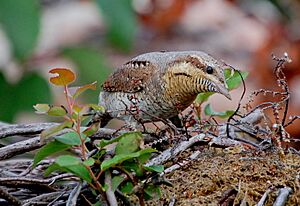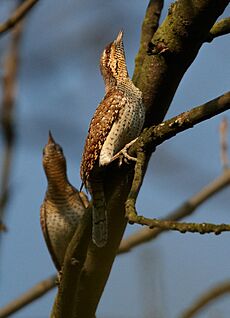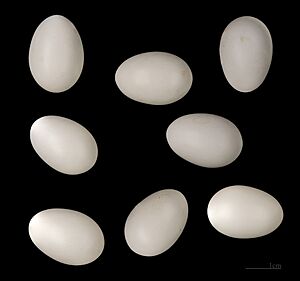Eurasian wryneck facts for kids
Quick facts for kids Eurasian wryneck |
|
|---|---|
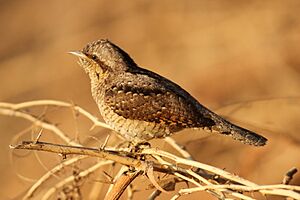 |
|
| Conservation status | |
| Scientific classification | |
| Genus: |
Jynx
|
| Species: |
torquilla
|
| Subspecies | |
|
See text |
|
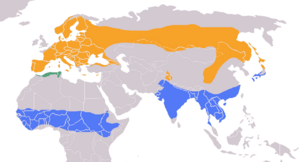 |
|
| Range map for Eurasian wryneck Summer Resident Winter |
|
The Eurasian wryneck or northern wryneck (Jynx torquilla) is a special type of wryneck bird. It belongs to the woodpecker family, but it's a bit different from other woodpeckers. These birds mostly live and have their babies in cooler parts of Europe and Asia.
Many Eurasian wrynecks are migratory. This means they fly long distances to warmer places for winter. They spend their winters in tropical Africa and southern Asia, from Iran all the way to India. Some wrynecks, however, stay in northwestern Africa all year round. These birds like open areas, woodlands, and fruit orchards.
Eurasian wrynecks are about 16.5 centimeters (6.5 inches) long. Their beaks are shorter and not as sharp as other woodpeckers' beaks. Their top feathers are a mix of light brown with black and reddish stripes. Their bellies are creamy white with brown spots. Wrynecks mainly eat ants and other insects. They find these bugs in old wood or on the ground. Like many birds that nest in holes, their eggs are white. A female wryneck usually lays seven to ten eggs in May or June.
These birds get their English name, "wryneck," from their amazing ability to twist their heads. They can turn their heads almost 180 degrees! If something bothers them at their nest, they twist their heads like a snake and hiss. This strange behavior makes them look scary to predators. Long ago, people thought this odd behavior was linked to witchcraft. This is where the word "jinx" comes from!
Contents
What is a Eurasian Wryneck?
The Eurasian wryneck was first described by a famous scientist named Carl Linnaeus. He wrote about it in his book Systema Naturae in 1758. The first bird he studied came from Sweden.
The name Jynx comes from an Ancient Greek word for this bird. The second part of its scientific name, torquilla, is from a Medieval Latin word meaning "to twist." This refers to how the bird twists its head. The English name "wryneck" also means the same thing. It was first used in 1585.
Wrynecks are part of the Picidae family, which includes woodpeckers. There are two types of wrynecks in the world. One is the Eurasian wryneck, and the other is the red-throated wryneck. The red-throated wryneck lives in Africa. There are six slightly different kinds, or subspecies, of the Eurasian wryneck:
- Jynx torquilla chinensis
- Jynx torquilla himalayana
- Jynx torquilla mauretanica
- Jynx torquilla sarudnyi
- Jynx torquilla torquilla
- Jynx torquilla tschusii
How to Identify a Eurasian Wryneck
The Eurasian wryneck is about 17 centimeters (6.7 inches) long. Some can weigh between 26 and 50 grams (0.9 to 1.8 ounces). It looks slender and long, more like a thrush than a typical woodpecker.
Its upper body has stripes and spots of light brown, reddish, and black. Its lower back and upper tail feathers are gray with brown spots. The tail is rounded and gray with faint brown bands. Its cheeks and throat are light brown with darker brown stripes. The belly is creamy white with brown arrow-shaped marks. These marks become spots lower down on the belly.
The wings have brown feathers with reddish-brown marks. Its beak is brown, long, and thin with a sharp tip. Its eyes are hazel, and its legs and feet are pale brown. Its feet are special for climbing trees. Two toes point forward, and two point backward, which helps it cling to tree trunks. Young wrynecks look a lot like adults but have lighter colors.
The Eurasian wryneck makes a loud, high-pitched call. It sounds like quee-quee-quee-quee and can last for several seconds. It's a bit like the sound of a lesser spotted woodpecker. When it's worried, it makes short "tuck" sounds. If it's disturbed in its nest, it will hiss like a snake.
Where Eurasian Wrynecks Live
The Eurasian wryneck lives across a large area called the palearctic region. This includes Europe, Asia, and parts of North Africa.
The wrynecks that live in Europe, all the way to Russia, are one type. Other types are found in places like Corsica, Italy, and parts of the Balkans. A type called J. t. mauretanica lives in Algeria and Morocco. Other types are found across Asia, from Siberia to the Himalayas and China. Some even live on islands like Sakhalin and Japan.
The Eurasian wryneck is the only woodpecker in Europe that flies very far for winter. European wrynecks fly south of the Sahara Desert in Africa. They go to countries like Senegal, Ethiopia, and the Democratic Republic of Congo. Wrynecks from Central and East Asia spend their winters in India or southern East Asia, including southern Japan.
In summer, these birds like open areas, parks, gardens, orchards, and places with hedges. They especially like areas with old trees. They can also live in forests where trees lose their leaves in autumn. In colder places like Scandinavia, they can even be found in pine forests.
Eurasian Wryneck Behavior
Eurasian wrynecks sometimes fly in small groups when they migrate or during winter. But in summer, they are usually seen in pairs. They often hold their heads high with their beaks pointing slightly up.
When two wrynecks meet, they might face each other. They pull their heads far back, open their beaks wide, and bob their heads up and down. Sometimes, a bird might let its head flop to the side. When they are very excited, they shake and twist their heads quickly. If you disturb a wryneck at its nest or hold it, its neck will twist in all directions. The bird might even pretend to be dead, hanging still with its eyes closed.
When wrynecks return to their breeding areas after migration, they choose their own territories. In Switzerland, they prefer old pear orchards with many ant nests. Areas used for growing vegetables are also good if they have bare ground where the birds can find food. Wrynecks often choose the same territories year after year. Having other wrynecks nearby also seems to be a good sign for them. Old orchards are popular because their thick leaves can have many aphids, which means more ants for the birds to eat.
The main food for Eurasian wrynecks is ants. But they also eat beetles and their young, moths, spiders, and woodlice. Even though they spend time in tree branches, they mostly look for food on the ground. They hop around with their tails held up. They can also cling to tree trunks, moving sideways. They don't peck holes in bark like other woodpeckers. Instead, they use their long, quick tongues to pick up insects. Sometimes, they even catch insects while flying. Their flight is usually slow and wavy.
Reproduction and Life Cycle
Eurasian wrynecks can nest in many different places. They might use an old hole in a tree, a crack in a wall, a hole in a bank, or even a sand martin's burrow. They also use nesting boxes. They look for a safe spot away from predators. Sometimes, they might even take over a nest from another bird, pushing out its eggs or young.
Wrynecks don't use any nesting material. The female usually lays seven to ten eggs, but sometimes it can be five, six, eleven, or twelve. The eggs are about 20.8 by 15.4 millimeters (0.8 by 0.6 inches) and are a dull white color. Both the male and female bird take turns sitting on the eggs, but the female does most of the incubation. The eggs hatch after twelve days. Both parents feed the baby birds for about twenty days until they are ready to fly from the nest. Usually, they only have one group of babies each year.
Eurasian Wryneck Status
The International Union for Conservation of Nature says the Eurasian wryneck is a bird of "least concern." This means it's not currently in danger of disappearing. There are estimated to be up to fifteen million of these birds worldwide, and they live in a very large area.
Even though their numbers might be going down a bit, it's not happening fast enough to make them a threatened species. In Europe, the biggest populations are in Spain, Italy, Germany, Poland, Romania, Hungary, Belarus, and Ukraine. Only in Romania are their numbers thought to be increasing. In Russia, where there are many wrynecks, we don't know if their numbers are going up or down.
In the United Kingdom, the number of wrynecks is decreasing. They are protected by law there. In Switzerland, their numbers have also gone down. However, efforts to help them, like adding nest boxes in good places, have shown positive results.



